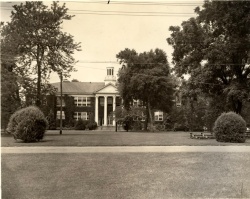Difference between revisions of "Bordentown Manual Training School"
(Created page with "{{infobox institution | name = Bordentown Manual Training School | image = bordentown.jpg | image_size = 250px | alt = | caption = | established = 1886 | construction_began = ...") |
m |
||
| (One intermediate revision by the same user not shown) | |||
| Line 25: | Line 25: | ||
The Manual Training and Industrial School in Bordentown was an important institution for the education of young African American men & women. It was founded in 1886 by an African Methodist Episcopal Minister, the Reverend W. A. Rice, in an effort to introduced the vocational education concepts of Booker T. Washington. Sometimes celebrated as the "Tuskegee of the North," The Bordentown School graduated approximately 100 students a year. The school focused on vocational trade training and academic studies for girls and boys from grades 8 to 12. In 1894, the state took over the school, which became known as the New Jersey State Manual Training and Industrial School for Colored Youth. | The Manual Training and Industrial School in Bordentown was an important institution for the education of young African American men & women. It was founded in 1886 by an African Methodist Episcopal Minister, the Reverend W. A. Rice, in an effort to introduced the vocational education concepts of Booker T. Washington. Sometimes celebrated as the "Tuskegee of the North," The Bordentown School graduated approximately 100 students a year. The school focused on vocational trade training and academic studies for girls and boys from grades 8 to 12. In 1894, the state took over the school, which became known as the New Jersey State Manual Training and Industrial School for Colored Youth. | ||
| − | The school closed | + | Over the next three decades dormitories, administration and assembly buildings, athletic fields, educational and vocational trades buildings were constructed. The 400-acre campus eventually included over thirty trade, academic, and residential buildings and two working farms. Students helped to run the school as part of their education. They operated the school’s farms and orchards, prepared meals, ran printing presses, repaired and maintained buildings, operated mechanical systems, and carried out major landscaping and site work projects. The curriculum included training in educational subjects and industrial and manual trades. |
| + | |||
| + | In June 1955, the Bordentown School closed, after the 1947 New Jersey Constitution made segregation in public education unlawful and the U.S. Supreme Court ruled racial segregation in schools and other public facilities to be unlawful. The state converted the school into the E.R. Johnstone Training Center for the developmentally disabled, which closed in the early 1990s. The campus is now a correctional facility operated by the New Jersey Juvenile Justice Commission. The New Jersey Manual and Industrial School for Colored Youth is listed in the National Register of Historic Places. | ||
| + | |||
| + | <gallery> | ||
| + | File:NJbordentown192443.jpg | ||
| + | </gallery> | ||
[[Category:New Jersey]] | [[Category:New Jersey]] | ||
[[Category:Closed Institution]] | [[Category:Closed Institution]] | ||
[[Category:Cottage Plan]] | [[Category:Cottage Plan]] | ||
Latest revision as of 22:31, 23 February 2016
| Bordentown Manual Training School | |
|---|---|
 | |
| Established | 1886 |
| Opened | 1896 |
| Closed | 1992 |
| Current Status | Closed |
| Building Style | Cottage Plan |
| Architect(s) | Charles N. Lowrie |
| Location | Bordentown, NJ |
| Architecture Style | Colonial Revival |
| Alternate Names |
|
History[edit]
The Manual Training and Industrial School in Bordentown was an important institution for the education of young African American men & women. It was founded in 1886 by an African Methodist Episcopal Minister, the Reverend W. A. Rice, in an effort to introduced the vocational education concepts of Booker T. Washington. Sometimes celebrated as the "Tuskegee of the North," The Bordentown School graduated approximately 100 students a year. The school focused on vocational trade training and academic studies for girls and boys from grades 8 to 12. In 1894, the state took over the school, which became known as the New Jersey State Manual Training and Industrial School for Colored Youth.
Over the next three decades dormitories, administration and assembly buildings, athletic fields, educational and vocational trades buildings were constructed. The 400-acre campus eventually included over thirty trade, academic, and residential buildings and two working farms. Students helped to run the school as part of their education. They operated the school’s farms and orchards, prepared meals, ran printing presses, repaired and maintained buildings, operated mechanical systems, and carried out major landscaping and site work projects. The curriculum included training in educational subjects and industrial and manual trades.
In June 1955, the Bordentown School closed, after the 1947 New Jersey Constitution made segregation in public education unlawful and the U.S. Supreme Court ruled racial segregation in schools and other public facilities to be unlawful. The state converted the school into the E.R. Johnstone Training Center for the developmentally disabled, which closed in the early 1990s. The campus is now a correctional facility operated by the New Jersey Juvenile Justice Commission. The New Jersey Manual and Industrial School for Colored Youth is listed in the National Register of Historic Places.
